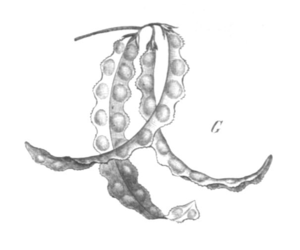Astragalus pelecinus
| Astragalus pelecinus | ||||||||||||
|---|---|---|---|---|---|---|---|---|---|---|---|---|

Saw sleeve ( Astragalus pelecinus ) |
||||||||||||
| Systematics | ||||||||||||
|
||||||||||||
| Scientific name | ||||||||||||
| Astragalus pelecinus | ||||||||||||
| ( L. ) Barneby |
The Sägehülse ( Astragalus pelecinus (L.) Barneby ; Syn .: Biserrula pelecina L. ) is a plant from the family of the Leguminosae (Fabaceae).
features
Astragalus pelecinus is an annual stem therophyte that reaches a height of 10 to 40 centimeters. The plant is short and downy. The leaves are unpinnate. The 15 to 31 leaflets are 5 to 10 × 1 to 5 millimeters in size and linear-oblong to ovoid-rounded. The chalice is bell-shaped and has 5 unequal teeth. The crown is 4 to 6 millimeters in size and colored blue or pale yellow, with a blue tip. The sleeves are 10 to 40 × 4 to 8 millimeters in size, narrowly elongated and compressed at the sides. Their saw-toothed edges are striking.
The flowering period extends from March to April.
The number of chromosomes is 2n = 16.
Occurrence
The species occurs in the Mediterranean area. In Crete it grows on dry wasteland at altitudes of 0 to 200 meters.
literature
- Ralf Jahn, Peter Schönfelder: Excursion flora for Crete . With contributions by Alfred Mayer and Martin Scheuerer. Eugen Ulmer, Stuttgart (Hohenheim) 1995, ISBN 3-8001-3478-0 , p. 146 .
Individual evidence
- ^ Astragalus pelecinus at Tropicos.org. In: IPCN Chromosome Reports . Missouri Botanical Garden, St. Louis